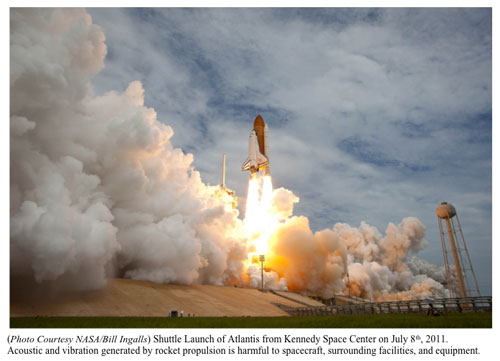 The noise generated by rocket exhaust during shuttle launch events generates considerable effects on the safety of spacecraft, ground facilities, and equipment. Accumulated stress threatens the safe operation of exposed systems. MicroStrain worked with NASA Kennedy Space Center researchers to implement a wireless sensor solution. The solution enabled web based monitoring of far-field shuttle launch acoustics. Test results corroborated prediction models with accurate, easily accessible field data. Furthermore, the deployed sensor network provides NASA with the foundation to implement a scalable remote sensor network capable of proactively monitoring high-value, hazardous systems.
The noise generated by rocket exhaust during shuttle launch events generates considerable effects on the safety of spacecraft, ground facilities, and equipment. Accumulated stress threatens the safe operation of exposed systems. MicroStrain worked with NASA Kennedy Space Center researchers to implement a wireless sensor solution. The solution enabled web based monitoring of far-field shuttle launch acoustics. Test results corroborated prediction models with accurate, easily accessible field data. Furthermore, the deployed sensor network provides NASA with the foundation to implement a scalable remote sensor network capable of proactively monitoring high-value, hazardous systems.
The overarching goal of the NASA rocket acoustics program is to monitor hazardous systems remotely. One system of particular interest for NASA to monitor is the Composite Overwrapped Pressure Vessel (COPV) used to house various types of pressurized fluids. COPVs are acutely subject to internal pressure and proximity to shuttle launch. Failure of these systems poses a significant threat to mission safety and assurance. Conventional, hardwired solutions cannot monitor the strain experienced by these hazardous systems due to limited accessibility and extreme operating conditions. NASA considered a variety of systems and found that MicroStrain’s sensing solutions met all of their requirements for this particular project.
MicroStrain’s project with NASA focused on quantifying the effects of acoustics and vibration on far-field equipment. Strict mission protocols prevented researchers from accessing the test area for several days before and after the launch. Uncertainty pertaining to the timing of launch sequence initiation further complicated testing conditions. As a result, deployed sensor systems were required to remain powered and alert in anticipation of a window of launch times. These conditions demanded that wireless sensor networks operate on limited power while still providing a measurement frequency capable of capturing the brief but dynamic nature of launch acoustics.
 Web Based Data Management
Web Based Data Management
Continuously collecting information over this length of time generates large amounts of data that can be difficult to navigate and transfer. Powerful data management strategies are required to identify and analyze key threshold data. MicroStrain’s solution addressed the data collection concerns and test environment considerations presented by the NASA project through a combination of advanced power management techniques, high performance wireless nodes, and its innovative new web based data management platform, SensorCloud®.
By implementing a combination of MicroStrain sensors and sensor services, NASA researchers were able to remotely monitor the far-field acoustic, pressure and vibration levels of the STS-134 Endeavour and STS-135 Atlantis launches at the Kennedy Space Center.
MicroStrain provided NASA with all the necessary hardware, software, and support to implement a wireless sensor system in this application. The system hardware consisted of two wireless G-Link® acceleration nodes, one wireless SG-Link® strain gauge, a wireless WSDA® data collection base station, and SensorCloud®. Nodes were instrumented on a cantilever plate with low natural frequency.The plate was installed on Shuttle PAD 39B which is neighboring to Shuttle PAD 39A where the last several launchs have taken place. At this location the plate is exposed to Acoustic and vibrational launch effects approximately 7000 feet from the Shuttle liftoff and where far-field acoustics are of interest.
Previous calculations performed by NASA estimated the peak acousitc loads at various distances, however, these levels were not used for determining damage effects.
After the successful departure of the spacecraft, data reduction was used to isolate the sensor data for the launch event. Initially, data was collected on a local PC. As a result of the five day measurement timeframe, the computer collected in excess of 3 gigabytes worth of information. NASA addressed the issue of viewing, navigating, and sharing such large amounts of data by uploading it to SensorCloud. On SensorCloud, MicroStrain support engineers collaborated with NASA researchers to seek and analyze key threashold data. Two sets of acceleration data from MicroStrain SG-Link strain gauges clearly indicated peak vibration levels. Results enabled NASA to compute the equivalent static load developed by the rocket and correlate the data to analyze predictions.
Scalable Platform Beyond model validation, the value of the described sensor network to NASA researchers includes the capability to wirelessly scale across a multitude of locations and equipment types. Wireless networks can be implemented where researchers do not have the access required to maintain wired networks.
Beyond model validation, the value of the described sensor network to NASA researchers includes the capability to wirelessly scale across a multitude of locations and equipment types. Wireless networks can be implemented where researchers do not have the access required to maintain wired networks.
In this way, MicroStrain’s sensor solution is capable of saving valuable NASA resources by proactively measuring strains exerted on high-value and potentially hazardous assets, such as COPVs. Smart data managment reduces potential maintenance costs and prevents premature replacement or failure. The result enables improved safety of monitored components and is a tool to support any issues of availability and maintainability of equipment and structures by condition.
Acknowledgements
The author thanks Rudy Werlink and Ravi Margasahayam of NASA Kennedy Space Center for sharing their application details and experience for this case study.
This paper does not represent an endorsement of any particular product or application by NASA.










